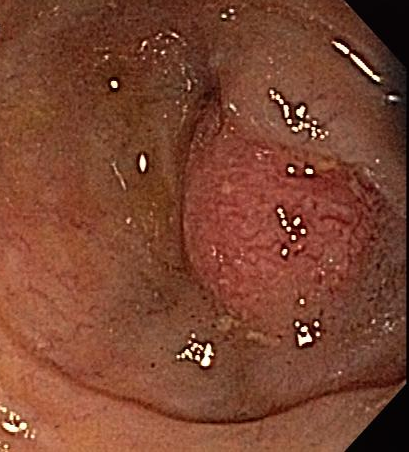- Clinical Technology
- Adult Immunization
- Hepatology
- Pediatric Immunization
- Screening
- Psychiatry
- Allergy
- Women's Health
- Cardiology
- Pediatrics
- Dermatology
- Endocrinology
- Pain Management
- Gastroenterology
- Infectious Disease
- Obesity Medicine
- Rheumatology
- Nephrology
- Neurology
- Pulmonology
Carcinoid Tumor of the Terminal Ileum
For carcinoid tumors of the GI tract, the rate of metastasis is related to size. Small tumors may be resected endoscopically but lesions 1 cm or larger require surgical resection.
Figure. Click to enlarge image.

A 50-year-old woman presents for a screening colonoscopy. During the examination, the terminal ileum is intubated and a circumferential mass measuring 1.3 cm is incidentally noted (Figure). A biopsy of the mass was taken and results of immunohistochemical staining were positive for chromogranin.
Questions:
1. What is your diagnosis?
2. What laboratory test can you order to screen for such tumors?
3. How should this mass be removed, endoscopically or surgically?
Answers:
1. This mass was a carcinoid tumor. Many of these are incidentally found, as in the presenting case, with the ileum being the most common site within the GI tract.
2. Measuring a 24-hour urine 5-HIAA (hydroxyindoleacetic acid) is a sensitive and specific test to screen for carcinoid. However, the sensitivity particularly depends on whether the tumor is functional (ie, carcinoid syndrome). In such cases, large amounts of serotonin are released in the systemic circulation causing symptoms such as flushing and diarrhea, both classically associated with carcinoid syndrome.
3. For carcinoid tumors in the GI tract, the rate of metastasis increases with size. For lesions smaller than 1 cm, the rate is 2%. However, for lesions larger than 2 cm, the rate of metastasis approaches 80%. Although some small carcinoid tumors in the bowel may be resected endoscopically, lesions that measure 1 cm or greater should undergo surgical resection with lymph node dissection.
Clinical Tips for Using Antibiotics and Corticosteroids in IBD
January 5th 2013The goals of therapy for patients with inflammatory bowel disorder include inducing and maintaining a steroid-free remission, preventing and treating the complications of the disease, minimizing treatment toxicity, achieving mucosal healing, and enhancing quality of life.
